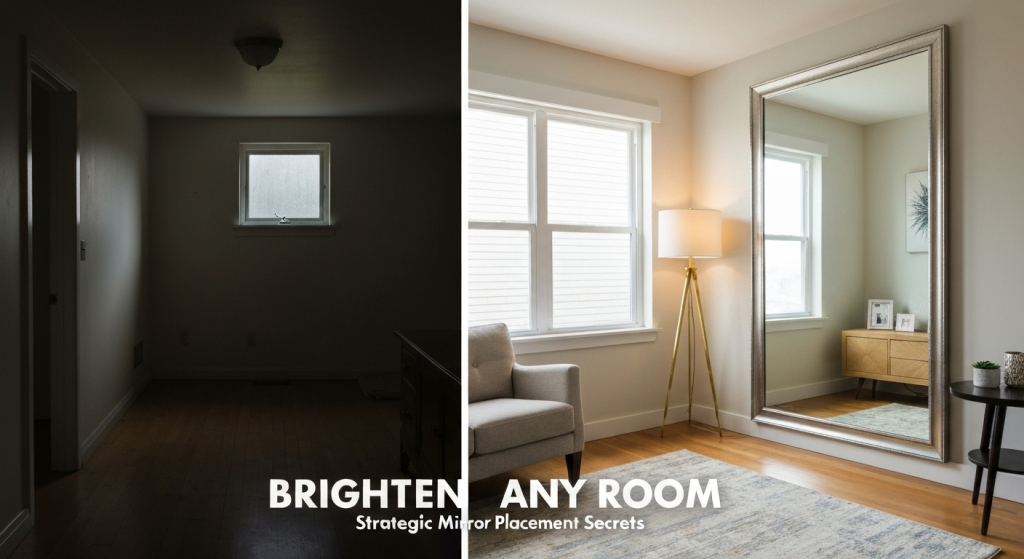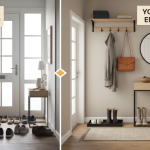A dark room can feel heavy and uninviting. It’s a common problem, especially in homes with small windows, challenging layouts, or north-facing exposures. You’ve probably heard the classic advice: “hang a mirror.” While true, that simple statement misses the most important part—the strategy. Simply putting a mirror on any wall is a missed opportunity. The real magic happens when you understand where to place it and why it works.
For over five years, I’ve been helping people rethink their spaces, and one of the most transformative tools in my kit has always been the humble mirror. I’ve seen firsthand how a single, well-placed reflective surface can completely alter the mood and brightness of a room. It’s not about expensive renovations; it’s about mastering the play of light. This guide is built from that experience, moving beyond generic tips to give you a clear, strategic approach. My goal here is to share what I’ve learned about turning dim, forgotten corners into bright, welcoming areas of your home.
This isn’t just about hanging something on a wall. It’s about using mirrors as a functional and beautiful tool to bounce, amplify, and sculpt the light you already have. Let’s break down exactly how to do it.
The Simple Science of Light: Why Mirrors Work
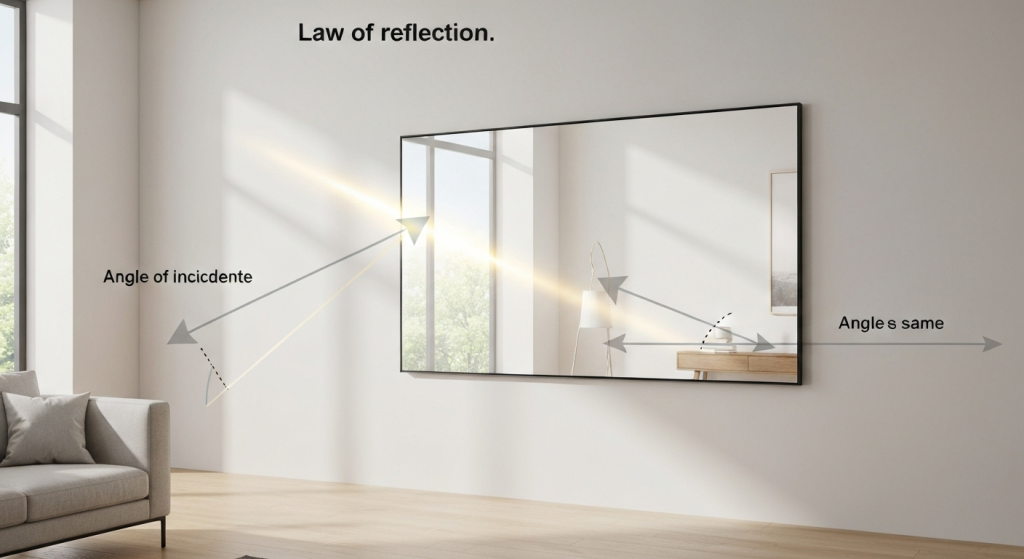
Before we get into specific placements, it helps to understand the basic principle at play. Think of light as a ball. When you throw a ball at a wall, it bounces off at the same angle it hit. Light works in a very similar way. This is known as the law of reflection: the angle at which light hits a mirror (the angle of incidence) is the same angle at which it bounces off (the angle of reflection).
What this really means is that a mirror doesn’t create light; it redirects it. Your job is to position the mirror so it catches the most light possible and sends it exactly where you need it most—into the darkest parts of your room. By understanding this simple concept, you can move from randomly guessing where a mirror should go to placing it with purpose for the biggest impact.
The Golden Rules of Mirror Placement for Maximum Light
Now for the practical part. There are three core strategies I always rely on to brighten a space. Think of these as your foundational rules for harnessing both natural and artificial light.
Rule #1: Place a Mirror Directly Opposite Your Main Light Source
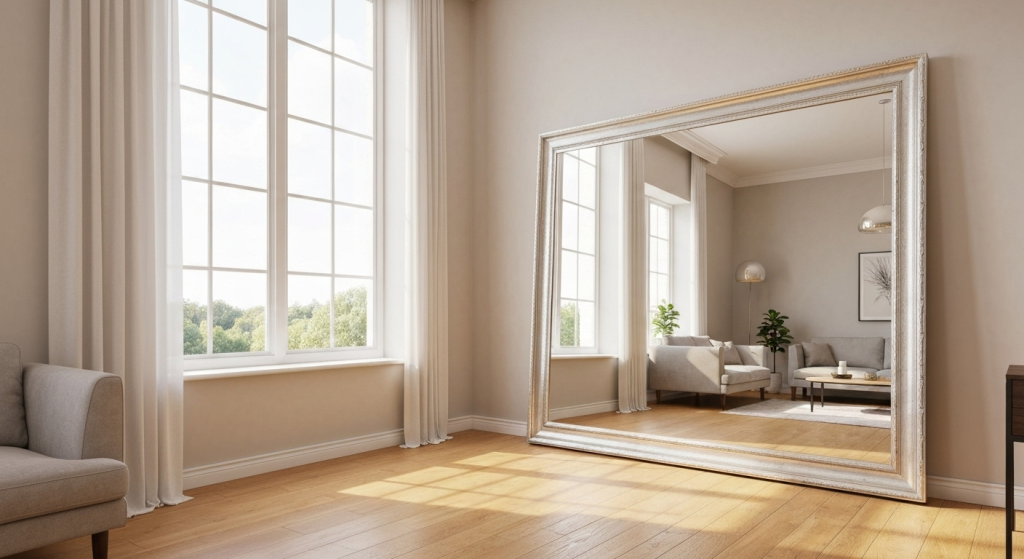
This is the most powerful technique in your arsenal. When you place a mirror directly opposite a window, you are essentially creating a second window. It captures the maximum amount of incoming daylight and reflects it straight back into the room, effectively doubling the brightness from that source.
This works wonders in living rooms, bedrooms, or dining areas where a single window leaves the rest of the space feeling dim. The key is to align the mirror as directly as possible with the window.
- For large windows or sliding glass doors: Use a large, statement mirror. A floor-length mirror leaning against the wall or a wide, horizontally mounted mirror will capture the most light and create a stunning sense of openness.
- For smaller windows: A medium-sized mirror will still do the trick. Ensure the mirror’s surface area is large enough to reflect the entire window frame and the view outside if possible. This not only brightens the room but also brings a piece of the outdoors inside.
In one project, I was working with a long, narrow living room that had a single window at the far end. The back half of the room felt like a cave. By placing a very large, simple-framed mirror on the opposite wall, we didn’t just brighten the dark end; we made the entire room feel more balanced and twice as large.
Rule #2: Place a Mirror Adjacent to a Light Source
Sometimes, placing a mirror directly opposite a window just isn’t possible. The opposite wall might have a door, a fireplace, or built-in shelving. In these cases, the next best strategy is to place the mirror on a wall adjacent (or perpendicular) to the window.
Here’s how it works: The mirror will catch the light as it streams in from the side and cast it deeper into the room. It won’t be as intense as the direct-opposite placement, but it’s incredibly effective for illuminating dark corners and adding a general lift to the room’s ambient light. I find this works especially well in:
- Home offices: Where a mirror next to the window can bounce light onto your desk area.
- Bedrooms: A mirror on the wall beside a window can help illuminate a dressing area or reading nook.
- Hallways: A long runner mirror placed on the wall next to a doorway that opens into a brighter room can pull that light into the darker corridor.
Rule #3: Amplify Your Artificial Lighting
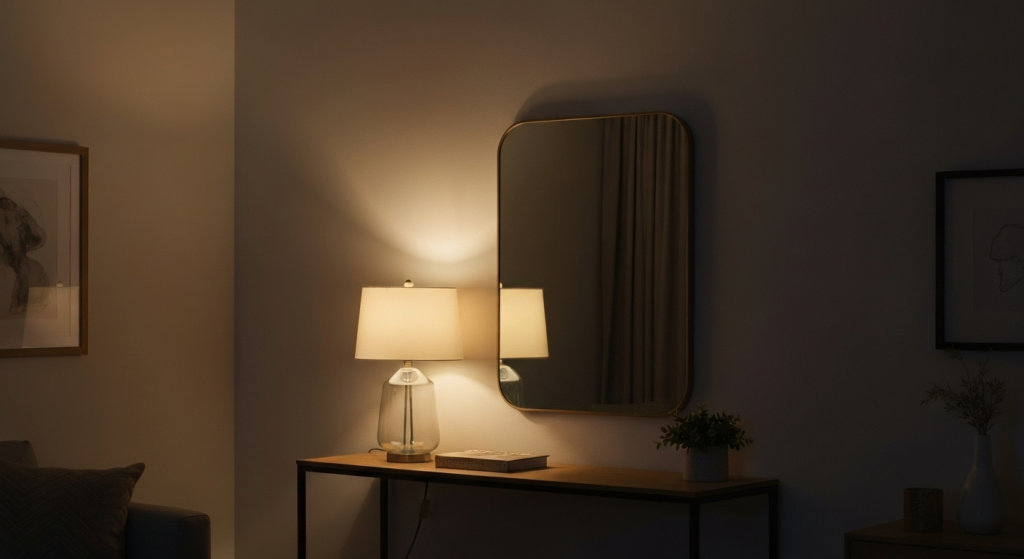
Your strategy shouldn’t stop when the sun goes down. Mirrors are just as effective at amplifying artificial light, creating a warm, inviting glow in the evenings. This is crucial for making a room feel cozy and well-lit at all hours.
Placing a mirror strategically can make a single lamp feel much more powerful.
- Behind a Table Lamp: Position a mirror on the wall behind a console or side table where a lamp sits. The mirror will reflect the light from the bulb and the soft glow of the lampshade back into the room.
- Near a Floor Lamp: A full-length mirror placed in a corner behind a floor lamp can make that corner feel intentionally bright and stylish.
- Opposite a Chandelier or Pendant Light: In a dining room or entryway, a mirror reflecting a beautiful light fixture not only doubles the light but also doubles the visual impact of the fixture itself.
Here’s a simple breakdown of how mirror placement can enhance different types of artificial lights.
| Light Source | Mirror Placement Strategy | Resulting Effect |
| Table Lamp | Place a small to medium mirror on the wall directly behind the lamp. | Creates a soft, warm pool of light. Makes the lamp feel more substantial and brightens the surface it sits on. |
| Floor Lamp | Position a tall, leaning mirror in the corner behind or next to the lamp. | Illuminates a dark corner, adds depth, and spreads the light both upwards and outwards. |
| Pendant/Chandelier | Hang a large mirror on a main wall that reflects the hanging fixture. | Doubles the fixture’s visual appeal and light output. Adds a sense of grandeur and sophistication, especially in dining rooms. |
| Wall Sconces | Place mirrors on the wall opposite the sconces. | Bounces the focused light across the room, creating balanced, ambient lighting. |
Choosing the Right Mirror: Size and Style Matter
The placement is crucial, but the type of mirror you choose also plays a significant role in both brightening the room and defining its style. The size, shape, and frame all contribute to the final effect.
Size and Scale: Bigger is Often Better
When your primary goal is to maximize light, a larger mirror is almost always the better choice. A small mirror can only bounce a small amount of light. A large mirror, on the other hand, can capture and reflect a significant swath of light, making a much more dramatic impact.
- Large Statement Mirrors: A single, oversized mirror can act as a focal point, much like a large piece of art. Leaning a floor mirror against a wall is a modern, relaxed approach that requires no drilling.
- Mirror Groupings: If a huge mirror isn’t practical or within budget, you can achieve a similar effect by grouping several smaller mirrors together. Arrange them in a grid or an organic cluster on a wall opposite a window. This breaks up the reflection but still bounces a lot of light around the room.
Frame Styles and Their Impact on Light
The frame of a mirror does more than just hold the glass in place; it’s a design element that contributes to the room’s overall feel. Some frames can even help amplify light further.
| Frame Style | Aesthetic | Effect on Light | Best For |
| Minimalist / Frameless | Modern, clean, unobtrusive | Maximizes the reflective surface area for a pure, bright reflection. | Small spaces or rooms where you want the mirror to blend in seamlessly. |
| Thin Metallic (Gold, Brass, Silver) | Elegant, glamorous, versatile | The metallic finish catches light and adds its own subtle shimmer and warmth (gold/brass) or coolness (silver). | Adding a touch of sophistication to living rooms, dining rooms, or entryways. |
| Natural Wood | Rustic, Scandinavian, warm | Adds texture and an organic feel. Lighter wood tones like oak or maple keep the look airy. | Bedrooms and living spaces where you want a cozy, grounded atmosphere. |
| Ornate / Antique | Traditional, classic, bold | Acts as a decorative art piece. The intricate details can be beautiful but may feel heavy in a very dark room. | Creating a strong focal point above a fireplace or in a formal dining room. |
| Windowpane Mirror | Farmhouse, industrial | The grid-like frame creates the illusion of an extra window, which is perfect for a dark room. | Placing opposite a solid wall to trick the eye and add architectural interest. |
Strategic Placements Beyond the Obvious Walls
Once you’ve mastered the main rules, you can start thinking creatively about other areas where a mirror can introduce light and the illusion of space.
The End of a Dark Hallway
Hallways often lack windows and can feel like dark tunnels. Placing a tall, vertical mirror at the very end of the hall works wonders. It will catch any light spilling in from adjacent rooms and pull it down the length of the corridor, making the space feel longer and infinitely brighter.
Above a Fireplace or Mantel
The wall above a fireplace is a natural focal point. Placing a large mirror here is a classic design choice for a reason. It reflects the room’s central space and any light fixtures, making the entire area feel more expansive and grand. It also reflects the cozy glow of the fire when it’s lit.
In an Entryway or Foyer
A mirror in the entryway is both practical for a last-minute check before leaving and strategic for light. Foyers are often small and can be dark. A mirror placed near the front door will catch the light from outside whenever the door is opened and will reflect the light from any overhead fixtures.
Mirrored Furniture and Backsplashes
Don’t limit your thinking to just wall mirrors.
- Mirrored Furniture: A side table, a cabinet with mirrored doors, or a console table with a mirrored finish can bounce light around at a lower level. This helps to brighten the floor area and the space under other furniture.
- Mirrored Backsplash: In a kitchen, a mirrored backsplash can be a game-changer. It brightens up the counter space under the cabinets, which is often shadowed, and makes a small kitchen feel much larger. The only downside is that it requires frequent cleaning to look its best.
Common Mistakes to Avoid (And How to Fix Them)
Placing a mirror can go wrong if you’re not careful. I’ve seen a few common mistakes that can actually make a room feel worse. Here’s what to watch out for.
- Reflecting Clutter: Remember, a mirror reflects everything. If you aim it at a messy bookshelf, a stack of papers, or an unattractive view, you’ve just doubled the clutter. Always consider what will be in the reflection before you hang the mirror. The goal is to reflect light or a beautiful view.
- Placing it Too High or Too Low: A mirror hung too high can feel disconnected from the room’s furniture and won’t reflect a useful view. A good rule of thumb is to hang the center of the mirror at eye level, which is typically around 57-60 inches (145-152 cm) from the floor.
- Creating an Infinite “Funhouse” Effect: Avoid placing two large mirrors directly opposite each other. This creates an endless reflection that can be disorienting and visually jarring.
- Ignoring the Room’s Energy: In bedrooms, some people find it unsettling to have a mirror directly reflecting the bed. Whether you subscribe to Feng Shui principles or not, it’s worth considering how the reflection will feel when you’re resting. Placing it on a wall adjacent to the bed is often a more comfortable choice.
Frequently Asked Questions (FAQs)
Can I use multiple mirrors in one dark room?
Absolutely. Using multiple mirrors can be very effective, especially if you create a gallery wall of smaller, decorative mirrors. The key is to ensure they are reflecting light or something beautiful, not just bouncing reflections of each other, which can look chaotic.
What’s the best shape of mirror for a small, dark room?
For small rooms, a large rectangular mirror—either vertical or horizontal—is often best. A tall vertical mirror draws the eye upward, creating a sense of height, while a wide horizontal mirror can make the room feel broader. An arched mirror can also soften the lines of a room and create the illusion of a window.
Will a mirror with an antique or “distressed” finish still brighten a room?
Yes, but not as effectively as a clear mirror. The antiqued or “foxed” finish diffuses the reflection, so it won’t bounce a sharp, clear beam of light. However, it will still reflect a soft, ambient glow and can add a lot of character and texture to a space.
Should the mirror frame match my other furniture or metal finishes?
It doesn’t have to match perfectly. In fact, mixing metals is a popular design trend. A brass-framed mirror can look beautiful in a room with black or chrome fixtures. The key is to choose a frame that complements the overall style and color palette of your room.
Conclusion
Using mirrors to brighten a dark room is one of the most effective and affordable design strategies available. It’s about more than just filling a blank wall; it’s about intentionally manipulating light to make your home feel more open, airy, and alive.
By placing a mirror opposite or adjacent to a light source, choosing a size and style that complements your space, and avoiding common mistakes, you can transform a gloomy room into a bright and inviting haven. Start with one key placement, see the difference it makes, and don’t be afraid to experiment. You’ll be amazed at how much brighter your home can feel.
